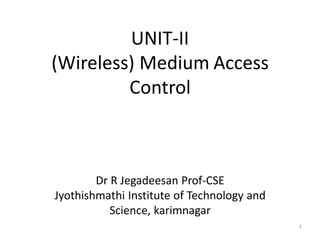Mobile computing (Wireless) Medium Access Control (MAC)
- 1. 1 UNIT-II (Wireless) Medium Access Control Dr R Jegadeesan Prof-CSE Jyothishmathi Institute of Technology and Science, karimnagar
- 2. 2 Contents 1. Motivation for Specialized MAC • Hidden and Exposed Terminals • Far and Near Terminals 2. Access Methods • SDMA • FDMA • TDMA • CDMA
- 3. 1. Motivation for Specialized MAC 3
- 4. 4
- 5. 5
- 6. 6 MULTIPLEXING • A fundamental mechanism in communication system and networks • Enables multiple users to share a medium • For wireless communication, multiplexing can be carried out in four dimensions: space, time, frequency and code
- 8. 8 2. Space Division Multiple Access (SDMA) • Channels are assigned on the basis of ―space‖(but operate on same frequency) • The assignment makes sure that the transmission do not interfere with each (with a guard band in between)
- 9. 9
- 10. 10 3. FDMA: Frequency Division Multiple Access 1. Frequency domain is subdivided into several non- overlapping frequency bands 2. Each channel is assigned its own frequency band (with guard spaces in between)
- 11. 11
- 12. 12 3. TDMA : Time Division Medium Access • A channel is given the whole bandwidth for a certain amount of time – All senders use the same frequency, but at different point of time • Synchronization can be done by using – Fixed Allocation Scheme or – Dynamic Allocation Scheme
- 13. 13
- 14. 14
- 16. Packet Reservation Multiple Access (PRMA) / Implicit Reservation 16
- 17. 17 • In this each terminal on the network is able to monitor the status of the channel before transmitting information • Variations: – 1-persistent CSMA – non-persistent CSMA - – p-persistent CSMA – CSMA/CA – Elimination yield – non-preemptive multiple access (EY-NMPA) Carrier Sense Multiple Access Protocols (CSMA)
- 18. Multiple Access with Collision Avoidance (MACA) 18
- 19. 19
- 20. POLLING 20
- 21. Inhibit Sense Multiple Access (ISMA) 21
- 22. 22 4. CDMA: Code Division Multiple Access ◼ separation of channels achieved by assigning each channel its own code ◼ guard spaces are realized by having distance in code space (e.g. orthogonal codes) ◼ transmitter can transmit in the same frequency band at the same time, but have to use different code ◼ Provides good protection against interference and tapping ◼ but the receivers have relatively high complexity.
- 23. Spread Aloha Multiple Access(SAMA) 23
- 25. Thank you

